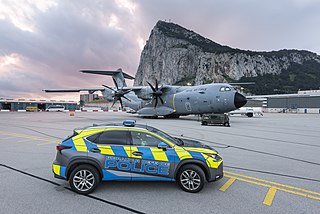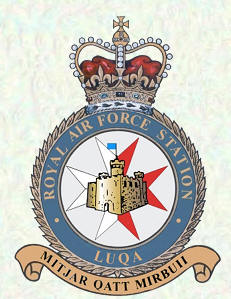
The Desert Air Force (DAF), also known chronologically as Air Headquarters Western Desert, Air Headquarters Libya, the Western Desert Air Force, and the First Tactical Air Force (1TAF), was an Allied tactical air force created from No. 204 Group RAF under RAF Middle East Command in North Africa in 1941 to provide close air support to the British Eighth Army against Axis forces. Throughout the Second World War, the DAF was made up of squadrons from the Royal Air Force (RAF), the South African Air Force (SAAF), the Royal Australian Air Force (RAAF), the United States Army Air Forces (USAAF) and other Allied air forces.

The former Royal Air Force Far East Air Force, more simply known as RAF Far East Air Force, was the Command organisation that controlled all Royal Air Force assets in the east of Asia. It was originally formed as Air Command, South East Asia in 1943 during the Second World War. In 1946, this was renamed RAF Air Command Far East, and finally Far East Air Force in June 1949.

No. 1435 Flight is a Typhoon FGR. 4 unit of the Royal Air Force, based at RAF Mount Pleasant, providing air defence for the Falkland Islands, South Georgia and the South Sandwich Islands. Permanently based in the islands, the aircrew and groundcrew from the UK are cycled through No. 1435 Flight, providing a 365-day, 24-hour alert.

The siege of Malta in World War II was a military campaign in the Mediterranean Theatre. From June 1940 to November 1942, the fight for the control of the strategically important island of the British Crown Colony of Malta pitted the air and naval forces of Fascist Italy and Nazi Germany against the Royal Air Force (RAF) and the Royal Navy.

RAF Gibraltar is a Royal Air Force station on Gibraltar. No military aircraft are currently stationed there, but RAF, Commonwealth and aircraft of other NATO nations will periodically arrive for transient stopovers, exercises, or other temporary duty. Administered by British Forces Gibraltar, the station is a joint civil-military facility that also functions as the Rock's civilian airport – Gibraltar Airport, with the civilian airport's passenger terminal building and apron facilities located on the north side of the runway while the apron and hangar of RAF Gibraltar are located on the south side of the runway.

Royal Air Force Luqa was a Royal Air Force station located on the island of Malta, now developed into the Malta International Airport.
No. 37 Squadron was a Royal Air Force squadron of the First and Second World Wars.

Operation Flax was a Western Allied air operation during the Tunisian campaign, as part of the larger North African campaign of the Second World War. It was designed to cut air supply between Italy and the Axis armies in Tunis, Tunisia, in April 1943. The parallel Allied naval effort was Operation Retribution.

The RAF Hal Far airfield was the first permanent airfield to be built on Malta. It was opened on 1 April 1929 as HMS Falcon, a Royal Navy stone frigate, and was used by Fleet Air Arm crews. It was transferred to the Maltese Government and redeveloped from January 1979. It is now closed and one of its runways is used by drag racing enthusiasts. The second runway is now a road leading to an industrial estate which was developed recently. The Maltese fire service, the CPD occupy the newer building with the glass control tower on the roof. The old Royal Naval Air Station building is now occupied by the International Safety Training College who utilise part of the runway for firefighting training.
Air Commodore John Marlow Thompson, was a Royal Air Force (RAF) officer and a flying ace of the Second World War. He is credited with having destroyed at least eight enemy aircraft.
No 81 Squadron was a squadron of the Royal Air Force. It flew Fighter aircraft during the Second World War, and reconnaissance aircraft in the Far East after the war and was disbanded in 1970.
No. 205 Group was a long-range, heavy bomber group of the Royal Air Force (RAF) established on 23 October 1941 by boosting No. 257 Wing to Group status.
Air Headquarters East Africa was a command of the British Royal Air Force (RAF) formed on 19 October 1940 by expanding AHQ RAF Nairobi. On 15 December 1941, the command was reduced to Group status as No. 207 Group. On 16 November 1942, Air H.Q. East Africa was reformed by raising No. 207 Group back to Command status again.
AHQ Iraq was a command of the Royal Air Force (RAF).

The former Royal Air Force Near East Air Force, more simply known as RAF Near East Air Force, was the Command organisation that controlled all Royal Air Force assets in the Eastern Mediterranean.
No. 185 Squadron RAF was a Royal Air Force Squadron formed in World War I and reformed as a bomber and fighter unit in World War II. It then reformed in Malta in the post war period as a jet fighter squadron.
No. 272 Squadron RAF was a Royal Air Force Squadron formed as an anti–submarine unit in World War I and a coastal fighter unit in World War II.

Royal Air Force Krendi, also known as RAF Qrendi, was a Royal Air Force base located on the island of Malta, near the town of Qrendi. The station was officially inaugurated in 1941 as a diversion airstrip for the main operating bases such as nearby RAF Luqa. Other diversion airstrips similar in function to Krendi were located at RAF Safi and on Malta's second island of Gozo. Later, in November 1942, the British began basing fighter squadrons at Krendi. These remained until late 1943. After the war, the airfield was used as a tracking station and vehicle park, before falling into disuse.

Royal Air Force Ta Kali was a Royal Air Force fighter operations base located on the island of Malta, which started life in 1940 as a diversion airstrip for the main operating bases such as RAF Luqa. Other diversion airstrips similar in function to Ta Kali were located at RAF Hal Far and on Malta's second island of Gozo at Xewkija airfield. The base's name reflects an anglicised corruption of the correct Maltese spelling of Ta' Qali, other phonetic variants of the correct name also appear regularly.

Mervyn Robert Bruce Ingram, was a New Zealand flying ace of the Royal New Zealand Air Force (RNZAF) during the Second World War. He is credited with at least eight aerial victories.













